

In the Garden | Upcoming Events | Rhubarb Festival | Books By Linda | Recipes
Bark, Compost & Fill Dirt | Garden Tips | About Linda | Contact
About Linda Stephenson
 For me gardening began at the knee of my father, Buck Matson. I used to tag along after him while he worked in his gardens in several locations in Bend, Oregon. For me gardening began at the knee of my father, Buck Matson. I used to tag along after him while he worked in his gardens in several locations in Bend, Oregon.
The first garden I can remember was a vegetable patch he put in. He used to turn over one of the large, empty black planting pots, pull up one for me to sit on and one for himself. We would sit out in the vegetable garden and he would peel and quarter turnips for us to munch on while he explained mixing the soil just right with compost and adding fertilizer. What did I know? I was only maybe 3 or 4 at the time and I didn’t know compost from dirt. I just enjoyed being a part of the whole concept of digging something out of the ground and eating it.
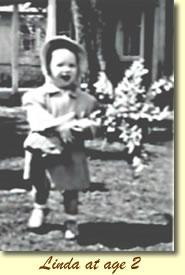 I remember one year as we were sitting in the garden he was saying that he was disappointed in the variety of carrots he had planted. I don’t remember what the variety was but according to his notes, from that garden on he only planted Danvers. His notation on the back of a seed packet of Danvers says “sweet carrot - plant 2 rows next spring”. I remember one year as we were sitting in the garden he was saying that he was disappointed in the variety of carrots he had planted. I don’t remember what the variety was but according to his notes, from that garden on he only planted Danvers. His notation on the back of a seed packet of Danvers says “sweet carrot - plant 2 rows next spring”.
Years later and married, I started planting gardens of my own in Bend. Dad was always there helping me or just a telephone call away. He would load up his pickup with a load of manure from his cow corral and dump it in my garden area. I’m a note keeper. I make notes on just about everything I do, and this includes the many gardens I have had in Bend and La Pine, Oregon where my nursery is located.
Not only am I an avid gardener, but I love the old family history. Family history gives us a background of who we are and sometimes a clearer picture of why we do what we do and why we love it. The following is a narrative of some of my family history and maybe a window into the past as to “why I do what I do”.

 I have several established plants, roses and wild plums, that came from cuttings I took at one of our old family homesteads in the Willamette Valley near Brownsville, Oregon. It was in the year 1849 when my Great Great Aunt Elizabeth Wilson Blain brought the first Sweet Brier Rose from her garden in Hebron, Indiana over the Oregon Trail and planted it in the Union Point, Oregon community of the Willamette Valley (this town no longer exists but for a small plaque along the roadside). Today this rose runs rampant throughout the valley and can be found on the dry hillsides, pastures and on many of the old homestead sites. I have this rose growing in my garden from cuttings taken from where the rose grew at the site of my Great Great Grandfather, James Wilson’s homestead south east of Brownsville, Oregon. I wanted to see if it was hardy enough for the La Pine area. It proved to be very hardy and blooms every year. I have several established plants, roses and wild plums, that came from cuttings I took at one of our old family homesteads in the Willamette Valley near Brownsville, Oregon. It was in the year 1849 when my Great Great Aunt Elizabeth Wilson Blain brought the first Sweet Brier Rose from her garden in Hebron, Indiana over the Oregon Trail and planted it in the Union Point, Oregon community of the Willamette Valley (this town no longer exists but for a small plaque along the roadside). Today this rose runs rampant throughout the valley and can be found on the dry hillsides, pastures and on many of the old homestead sites. I have this rose growing in my garden from cuttings taken from where the rose grew at the site of my Great Great Grandfather, James Wilson’s homestead south east of Brownsville, Oregon. I wanted to see if it was hardy enough for the La Pine area. It proved to be very hardy and blooms every year.
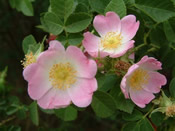 Known as the ‘Sweet Brier Roses’ or as common wild roses, this is a favorite English native that has been recorded in literature from Chaucer to Shakespeare. R. eglanteria, has been common in cottage gardens on both sides of the Atlantic because it is not only hardy but always fragrant, whether or not it is in bloom. The rambling shrub is large, thorny, and vigorous with dark green, slightly rough foliage. Spring flowers are pink, or red with five petals and have a good rose fragrance of their own. Rain, wind and sun all seem to bring out the perfume of the plant. This particular rose grows from 5 to 15 feet tall. I sell several varieties of wild roses in my nursery, Red Leaf and Grootendorst. Known as the ‘Sweet Brier Roses’ or as common wild roses, this is a favorite English native that has been recorded in literature from Chaucer to Shakespeare. R. eglanteria, has been common in cottage gardens on both sides of the Atlantic because it is not only hardy but always fragrant, whether or not it is in bloom. The rambling shrub is large, thorny, and vigorous with dark green, slightly rough foliage. Spring flowers are pink, or red with five petals and have a good rose fragrance of their own. Rain, wind and sun all seem to bring out the perfume of the plant. This particular rose grows from 5 to 15 feet tall. I sell several varieties of wild roses in my nursery, Red Leaf and Grootendorst.
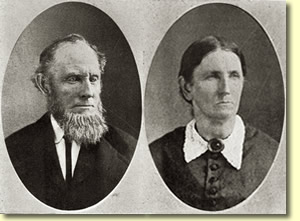 In the year 1853 my Great Great Grandfather James H. Wilson, along with his wife Mary Dinwiddie Wilson and their four children traveled the Oregon Trail from Hebron, Indiana and settled in the Brownsville, Oregon area on his Donation Land Claim. My Great Grandfather, Thomas Jay Wilson was 7 months old at time of the crossing. In those days wheat was foremost in the thoughts of every immigrant. They would locate their claim, build a cabin and then start clearing the land for a garden and a large area for a wheat crop. In the year 1853 my Great Great Grandfather James H. Wilson, along with his wife Mary Dinwiddie Wilson and their four children traveled the Oregon Trail from Hebron, Indiana and settled in the Brownsville, Oregon area on his Donation Land Claim. My Great Grandfather, Thomas Jay Wilson was 7 months old at time of the crossing. In those days wheat was foremost in the thoughts of every immigrant. They would locate their claim, build a cabin and then start clearing the land for a garden and a large area for a wheat crop.
The place of wheat in the economy of the new land was very important. In 1845, a territorial law was passed setting up how debts might be paid, because a man might be considered prosperous, as was my Great Great Grandfather, he might not have any money. The law stated that for payment of taxes and satisfaction of court judgments, the following were legal tender; gold, silver, treasury warrants, approved orders of solvent merchants, and wheat. I found stated in one of the old journals that in the beginning of setting up the new homestead, wheat was exchanged for almost all of their possessions.
After the garden and wheat fields were in place, then thoughts turned toward an orchard. At the time of grandfathers arrival, fruit trees were already coming into bearing.
It seems, according to Linn County historical records, that a man by the name of Henry Peterson settled upon his claim in 1845. He was a nurseryman. Whether he brought seeds or plants over the Oregon Trail is unknown. Many early orchards in this region came from the Peterson nursery. Among the fruit trees distributed by the Peterson nursery was a small red plum, very tart and sharp in flavor. This plum is still plentiful throughout Linn County under the name of the “Peterson Plum.”
About 15 years ago my husband, Sonny and I visited my Great Great Grandfathers homestead again. We got permission from the currant owners to dig starts from the old plum trees. The trees were planted in my La Pine garden and took hold, after about five years they did produce a small amount of fruit. When I started my nursery in La Pine in 1990, I could not find the Peterson Plum available commercially. So, I looked for a plum hardy enough for the La Pine climate. What I came up with, after planting many varieties and journaling them as to hardiness and on occasion producing fruit, was the Native American Plum, Toka, Superior and Mount Royal. I started selling these varieties for the first time in 2005. All of these trees need a cross pollinator, two different varieties.
I also found in several of my ancestors letters back and forth to each other, the varieties of jelly that was being preserved from native plants found in the valley. Of course there was the blackberry, which was abundant when they arrived in the valley, but will not grow in my area. They also used Serviceberry, also known as Juneberry. The berry was used in jams, jellies and wines. In addition, I found that they used the juice from this berry as a dye. Today I sell Serviceberry and Gooseberry plants that produce fruit every year.

 In 1900 my Great Grandfather, Thomas Jay Wilson, brought his family to Central Oregon by horse and wagon over the Barnes Road near Mount Hood, (Thomas Jay Wilson was 7 months old at the time the crossing was made from Indiana to Oregon). He obtained 160 acres under the Oregon Homestead Act, east of highway 97, just before Madras, Oregon on what is now known as Norris Road. As his father before him, his first job was to build a home and then concentrate on his farming. He also transplanted many of the fruit trees that were grown in the Willamette Valley. Some thrived and others were not hardy enough. Letters state that he had quite a large vegetable garden also. In 1900 my Great Grandfather, Thomas Jay Wilson, brought his family to Central Oregon by horse and wagon over the Barnes Road near Mount Hood, (Thomas Jay Wilson was 7 months old at the time the crossing was made from Indiana to Oregon). He obtained 160 acres under the Oregon Homestead Act, east of highway 97, just before Madras, Oregon on what is now known as Norris Road. As his father before him, his first job was to build a home and then concentrate on his farming. He also transplanted many of the fruit trees that were grown in the Willamette Valley. Some thrived and others were not hardy enough. Letters state that he had quite a large vegetable garden also.
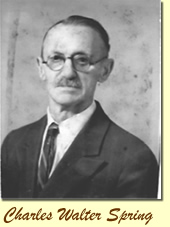 Across the hills in Prineville, Oregon my other Great Grandfather, Charles Walter Spring obtained property in March of 1910. On this property, he started Prineville Green House. According to his ads, that I found in the Crook County Journal, Prineville’s then weekly newspaper, his ads started on June 8, 1911, he states that he is offering “All kinds of vegetable and flower plants ready to transplant to the open ground at the proper season. All plants transplanted and well rooted. Pot grown tomato and cucumber plants. Vegetables out of season. We now have help in the work and some one will always be on hand to wait upon you. A good article at a reasonable price is our aim. No extra charge for packing and delivery at the stage office.” Charles W. Spring Across the hills in Prineville, Oregon my other Great Grandfather, Charles Walter Spring obtained property in March of 1910. On this property, he started Prineville Green House. According to his ads, that I found in the Crook County Journal, Prineville’s then weekly newspaper, his ads started on June 8, 1911, he states that he is offering “All kinds of vegetable and flower plants ready to transplant to the open ground at the proper season. All plants transplanted and well rooted. Pot grown tomato and cucumber plants. Vegetables out of season. We now have help in the work and some one will always be on hand to wait upon you. A good article at a reasonable price is our aim. No extra charge for packing and delivery at the stage office.” Charles W. Spring

This is a further indication that our family must have been born with farming in the blood and dirt under the finger nails. Who would have thought that I would follow in my Great Grandfather’s foot steps 100 years later. Selling many of the same plants and offering “A good article at a reasonable price is our aim.” But since we do not have a stage office you will have to pick up your plants at the nursery in La Pine, Oregon or we can deliver within the area, but we will use a truck not a horse and wagon.
As you can see farming and growing plants, trees and shrubs has been in the blood of many generations of my family. Even though many notes were kept, many are now unreadable and very fragile. Twenty two years ago I spent a winter going over varieties planted and did a lot of test planting the following spring to see which varieties were the hardiest. This was before I had any thoughts of operating a nursery. At the time I was a real estate agent here in La Pine. Many people would sit at my desk, wanting to buy property and telling me of all the things they were going to grow. Obviously they did not have a clue as to the extreme fluctuations of weather in Central Oregon.
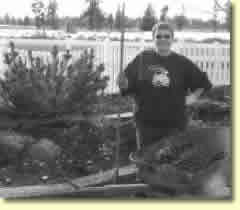 It was at this time that we had bought an additional 2 acres next to our home on S. Huntington Rd. We put up a greenhouse on this property for me to grow plants for our yard. At that time you could not buy plants that were hardy for our area here in La Pine. I grew a few extras the next spring and one thing led to another as word spread that you could get hardy plants grown for our area at my greenhouse. The following winter I made a decision to give up my real estate license and operate a full fledged nursery. L & S Gardens was born out of listening to my father, ancestors, reading their notes and through lots of experimenting on my own. It was at this time that we had bought an additional 2 acres next to our home on S. Huntington Rd. We put up a greenhouse on this property for me to grow plants for our yard. At that time you could not buy plants that were hardy for our area here in La Pine. I grew a few extras the next spring and one thing led to another as word spread that you could get hardy plants grown for our area at my greenhouse. The following winter I made a decision to give up my real estate license and operate a full fledged nursery. L & S Gardens was born out of listening to my father, ancestors, reading their notes and through lots of experimenting on my own.
Now 28 years later, we have 6 unheated greenhouses and 2 acres full of plants, trees and shrubs available for the gardener that is looking for the “Hardiest of the hardy” plants, trees, and shrubs for their yard.
I have taken all of the notes I have accumulated and put them into my gardening book called Cold Climate Gardening, available at my nursery or mail order under Books by Linda on this website.
L & S Gardens
“28 Years in Business and Still Growing”
linda@lsgardens.com
541-536-2049
|

![]()